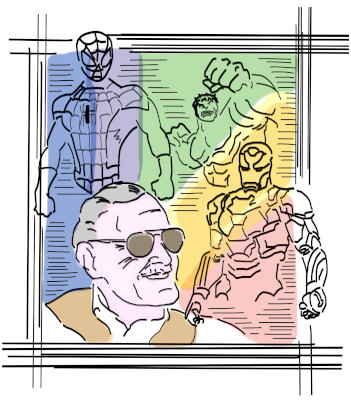Stan Lee, former editor-in-chief of Marvel Comics and co-creator of characters such as Spider-Man, Doctor Strange and Black Widow, passed away Nov. 12, 2018 at the age of 95. As the veritable face of Marvel Comics, Lee ushered in and helped to define the modern era of comic books and the pop culture landscape of the 21st century.
Following Lee’s death, an outpour of reactions and tributes came from the film, comic book and fan communities. Chris Evans, the actor who currently plays Steve Rogers/Captain America in the Marvel films, issued his condolences via Twitter.
“There will never be another Stan Lee,” Evans said. “For decades he provided both young and old with adventure, escape, comfort, confidence, inspiration, strength, friendship and joy. He exuded love and kindness and will leave an indelible mark on so, so, so many lives. Excelsior!!”
John Martin, the social media manager for the comic book store Comics vs Toys on Colorado Boulevard, said Lee’s passing left a profound impact on him.
“I was surprised because I was a critic of Stan’s, but I can’t deny his warmth as a human being and as a creator and as a businessman,” Martin said. “He injected a community into the business.”
Stan’s passing takes place amid an authentic renaissance of his life’s work. Since the release of 2008 film “Iron Man” with Robert Downey Jr., the Marvel franchise leaped from the pages of comic books to the multiplex and has since expanded into one of cinema’s most lucrative franchises. After “Iron Man,” The Incredible Hulk” and “Thor” — movies based on Lee’s characters — would follow in 2008, culminating in 2012’s “The Avengers.” Six years later and now 20 films deep, the Marvel Cinematic Universe has come to dominate the popular film landscape. Without Lee’s prior work, it would be nothing.
Lee’s greatest contributions were not solely the films his creations inhabit, but the characters themselves. For all of their exceptional capabilities, Lee’s creations were people first and heroes second.
“What I tried to do was take these characters, who are obviously bigger than life and fictitious, and make them seem real,” Lee said in a 2015 interview with The New York Times. “They’ve got these powers. They do wonderful things. But what are the things that worry them? What are the things that frustrate them?”
The characters Lee conceived in the 1960s were considered revolutionary. Comics before Lee predominantly featured one-dimensional characters distinguished and defined by a single extraordinary trait such as incredible strength, but little in terms of wants, needs and concerns.
“I didn’t want to do superheroes just like Superman or Batman. I wanted something a little more original, and where I played up the personalities of the characters more, and where there were surprises,” Lee said in the aforementioned interview. “If you’re writing about people, you have to make the people come to life.”
According to Martin, Lee’s characters succeed because of the emphasis on portraying them as people above all.
“Emotional ability and relatability were key. Spider-Man was relatable because he was a skinny nerd. That’s very special, I think,” Martin said. “That’s what makes Marvel great: because it relates to our real word.”
Much like his characters, Lee himself was far from a perfect person. Lee infamously overshadowed the work done by prolific comic artists Jack Kirby and Steve Ditko in creating characters like Doctor Strange and Iron Man. In particular, the use of the “Marvel Method,” in which Lee outsourced writing to Kirby and Ditko but claimed the work as his own, has been a controversial point for many years. To call Lee the sole creator of many modern Marvel characters disregards the work done by Kirby and Ditko. However, according to comic book writer Mike Mignola, to say that Lee stole everything from Kirby and Ditko is another misconception.
“You can debate forever who really created what — Stan or Jack or Steve — but the truth is it was some magic combination of those guys,” Mignola said in a recent Twitter post. “It made a big different (sic) to a whole lot of our childhoods and the world continues to be a richer place thanks to what they gave us.”
Today’s youth have likely never read a story directly by Lee, Kirby and Ditko, but they undoubtedly recognize Lee’s role and know his work. Lee’s characters, such as Black Panther, have thoroughly embedded themselves in the cultural moment, while other parts of the Marvel universe continue to spread throughout film and television. Lee himself may no longer be around, but the impact he has had and will continue to have on millions of people, young and old, will persist.
![]()



































